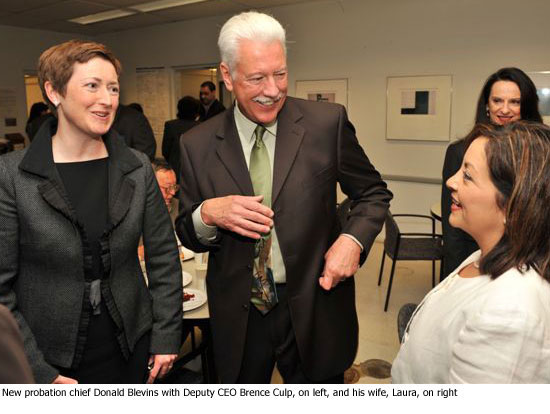A word about the budget…
April 19, 2010
This week, Los Angeles County—like local jurisdictions throughout the state—will officially open budget season when the County’s Chief Executive Officer unveils his proposed spending blueprint for the 2010-11 fiscal year beginning on July 1.
Like cities and counties throughout California, our County has been squeezed hard by the ailing national economy and lagging tax revenues. Thankfully, for all that, we are still in much better financial shape than most of our urban local government colleagues.
At a time when the budget woes in the City of Los Angeles seem to lead the news on a daily basis, people often ask me how the County has managed to stay solvent and financially stable. It was not always this way, but the reasons today are pretty simple: Since 1995, we have managed our finances with prudence and restraint. In short, we have lived within our means.
For me and my fellow members of the Board of Supervisors, the events of early 1995 taught us a harsh but essential lesson in fiscal discipline. Shortly after I was sworn in as County Supervisor, and not long after Orange County declared bankruptcy, Los Angeles County was faced with near bankruptcy itself, because at that time we were spending $1 billion a year more than we were taking in—by any definition, a prescription for trouble.
I remember the day we were advised that one of the banks that was holding our bonds wanted to have a conference call with the Board of Supervisors—all five of us. The bank—based in Switzerland—informed our Executive Officer that they were scheduling the call for a Tuesday at 10:00 a.m. They were told that would be impossible, because it would conflict with the Board’s weekly public meeting every Tuesday at 9:30 a.m.
Zurich replied loud and clear: “We will call at 10:00 a.m. on Tuesday, and we want the entire Board on the call.”
When your bank lender calls like that, you better take the call, so at the appointed hour we recessed our meeting and reconvened in a conference room with our bankers on the speaker phone. They wanted to know how serious we were about getting the county’s finances in order, and specifically: What we were going to do about it? How would we address our employee compensation issues? Were we prepared to cut spending in other areas? Were we willing to pare down the number of County employees? What steps were we prepared to take to ensure that our budget would be structurally sound, not perpetually out of whack?
We assured our Swiss partners that we were serious and outlined exactly what we were prepared to do. Not only did we convince the Swiss bankers, even more importantly we convinced ourselves. From the moment we hung up the phone on that call, we collectively committed never again to allow ourselves to come face-to-face with municipal bankruptcy.
Since then we have operated on a set of basic but essential fiscal principles. When times are flush, we don’t initiate programs that we can’t sustain through the inevitable lean years. And that’s also the moment for us to set aside a healthy reserve on which we can later draw to see us safely through the inevitable hard times.
Equally important, we have cultivated and nurtured an open and mutually trusting relationship with our employee organizations, asking their members to join in the necessary sacrifice during tough times with the expectation that we would make it up to them when the economy got well again. As much as anything, this partnership based on mutual respect and trust has helped smooth out the peaks and valleys that most other governments are struggling with today.
So, here we are, two years into the worst economic downturn since the Great Depression, and the County has avoided the kind of draconian measures that the State of California and many local governments have already been forced to embrace. We have seen no mass layoffs; no furloughs; no pay cuts. Not yet.
The paradox of county budgeting is that demand for our brand of social services—health and mental health care, child protection, public assistance, juvenile justice—tends to rise dramatically just when the economy and revenues are slumping. It makes running a county significantly more complicated than a city, which primarily takes care of municipal services and infrastructure maintenance than human services like health and public welfare.
Make no mistake, the county’s proposed budget for the upcoming fiscal year will be lean with cuts that will be felt. It calls for the elimination of more than 1,000 positions that are now vacant as well as a relatively small number of layoffs. While we’ll be unable to significantly expand our programs, we won’t be slashing them, either.
Sheriff Lee Baca, for example, will be downsizing one of his jails, but has avoided shutting it down altogether. We may have to consolidate the services provided at our Community Public Health Centers, but the services will continue to be available. And, some of our libraries may have to reduce their hours, but no one is closing their doors.
If the economic recovery, of which there is some evidence, should once again slip into reverse, even the most tightly managed County budget will take further and more painful hits. On the bright side, if things continue to pick up, and our tax coffers are steadily refilled, the County will make it through the current economic crisis without great drama.
Ongoing fiscal discipline and an unshakeable commitment to living within our means have served us well for the past 15 years. Had we managed our finances less prudently, we would once again find ourselves teetering on the brink of insolvency. But because we can remember our fiscal past, we are not condemned to repeat it.
Posted 4-19-10
Click here to read more blog entries.
CEO tightens county’s belt
April 19, 2010
Reflecting the hardships of the prolonged recession, Los Angeles County Chief Executive Officer William T Fujioka unveiled a proposed budget Monday that attempts to close a $510-million deficit by cutting labor costs, reducing some services and dipping into reserves set aside during better times.
The measures suggested by Fujioka, however, are far less severe than those being pursued by other local governments, including the City of Los Angeles, where officials have proposed sweeping cuts in services and jobs to avert a full-blown financial crisis.
“The County of Los Angeles is still in a very, very strong position,” said Fujioka, who credited prudent budgeting by the five-member Board of Supervisors.
Fujioka’s $22.7 billion budget for fiscal year 2010-2011 proposes a combination of departmental cutbacks that include the elimination 1,374 budgeted but unfilled jobs. Fujioka proposes withdrawing $167 million from reserves, one dubbed the “rainy day fund.” He predicted that actual layoffs would likely number less than 100, thanks in part to an agreement last year with unions that provided for two-year contracts with no additional cost-of-living raises.
That said, Fujioka said his office is still negotiating with labor representatives to find another $115 million in cuts. He declined to provide specifics.
Given early but encouraging signs of an economic rebound, Fujioka said during a meeting with reporters and county officials that next year’s $22.7 billion budget, which is 3.7 percent less than this year, could represent the leanest of all.
“We’re predicting that next year will be the most difficult [of the past three] for the county,” he said.
Deep recessions undermine county finances by reducing local tax revenues and state funding while raising demand for vital welfare and health care services for the county’s neediest residents, whose numbers climb in tough economic times.
Here are some of the highlights of the CEO’s spending plan:
• The Sheriff’s Department would absorb a predicted $128 million cutback, resulting in the elimination of 300 budgeted but vacant positions and a reduction of overtime spending that has put the department’s brass—including Sheriff Lee Baca—back in patrol cars. The District Attorney’s Office could lose up to 25 unfilled positions and face a spending reduction of $7.9 million.
• The Health Services Department would face a $362.4 million cut, although the CEO’s office and the department have yet to say where those reductions would be found.
• Public libraries would see reduced hours at some branches as they absorbed a $4.5 million budget cut. Also eliminated would be adult-literacy programs.
• Total budgeted county employment would drop from 101,113 to 99,736.
• County welfare spending would climb, including a predicted 12.6 percent hike in residents who request General Relief, the stop-gap welfare payment of $221 per month for the county’s neediest residents. The caseload for In-Home Supportive Services, a state funded program to help the elderly and infirm stay in their homes, would grow by 5.5 percent, according to budget assumptions, and the CalWORKS assistance program, helping families with children, would grow by $151.7 million.
The unveiling of the budget is the first step in a long process that includes Board of Supervisors hearings in early May and adoption in June.
Even after the new fiscal year begins July 1, budgets will have to shift as the uncertainties of projected revenue estimates give way to the sometimes harder realities of actual tax collection and funding from state and federal sources. In fact, the budget is not fully finalized until September.
What’s more, substantial revisions could occur because of revenue assumptions used by Fujioka and his budget team. They made the calculation, for example, that property tax receipts would drop by 2 percent for the year, although the Assessor’s Office predicted a drop of 2.7 percent. The budget also assumes that Congress will come through with $40 million in federal matching funds for health-care programs.
And then there are the uncertainties of Sacramento.
Fujioka said that Gov. Arnold Schwarzenegger’s proposed state budget would slash $1.5 billion from the county, if passed untouched. But the CEO said that won’t happen. He suspects that the final state budget could, indeed, create more financial problems for the county but that it’s too early to know how severely. Fujioka said that’s why he did not factor any possible Sacramento cuts into his proposed budget.
Posted 4-18-10
The passing of a chief
April 16, 2010
When word of Daryl Gates’ death hit the news today, I immediately thought back to the years of our overlapping tenures, when I served on the Los Angeles City Council.
We both held strong views about law enforcement and its practices and passionately defended those positions. Our often tempestuous relationship is well documented.
But one of the things I always respected most about Chief Gates was that he never let our disagreements—over the issues of civil liberties, police intelligence practices or excessive use of force—get in the way of the things about which we agreed, such as growing the police department and addressing the LAPD’s other pressing budgetary needs.
On a personal level, I will always remember his generosity. Despite our differences, Chief Gates never turned down my requests to join me in charitable undertakings on behalf of the Los Angeles Free Clinic or the legendary mile race that we ran at UCLA to raise funds for the young girl who was run over in Westwood Village the night before the opening of the 1984 Olympic Games.
I last spoke with Chief Gates a few months ago at the swearing-in of Chief Charlie Beck. We both reminisced about our confrontations, but we also acknowledged the mutual respect we had for one another.
Daryl Gates will go down as one of the most important leaders in the LAPD’s history. With my wife Barbara, whom he really admired, we extend our deepest sympathies to his family.
Posted 4-16-10
Click here to read the Los Angeles Times’ obituary of Chief Gates
Click here to read more blog entries.
Proposed county budget to be unveiled
April 15, 2010
Los Angeles County Chief Executive Officer William T Fujioka will unveil the proposed county budget for fiscal year 2010-2011 at a press roll-out Monday morning, April 19, at the Kenneth Hahn Hall of Administration. The detailed budget documents will be made available Monday on-line at 8 a.m. at lacounty.gov. Previous county budget documents are available here, including for the current fiscal year’s $23.6 billion spending plan.
The coming year’s proposed budget has been scheduled for consideration the following day at the Board’s weekly meeting. This action begins the formal budget adoption process, which continues with public hearings and testimony on May 12, followed by the Board’s own deliberations on June 7, which will incorporate the supervisors’ various changes to the initial spending plan.
But that still won’t be the end of the process. That won’t happen until September, when the county gets a final handle on how much money flowed into the county at the close of this fiscal year from state and federal funds and other tax and revenue collections.
Posted 4-15-10
Board set to consider new green initiative
April 15, 2010
The Board of Supervisors will be asked to green-light three innovative projects at waste-recycling and transfer facilities in Riverside and Orange Counties as alternatives to solid-waste disposal in area landfills. The projects will be monitored and evaluated to develop future opportunities to pursue similar projects within Los Angeles County.
Under the proposal, the county’s Department of Public Works would engage CR&R Inc., International Environmental Solutions and Rainbow Disposal Company, Inc. to operate the facilities. The department would also enter into a four-year, $1.3 million contract with environmental consultant Alternative Resources Inc., to design and oversee the Southern California Conversion Technology Demonstration Project.
The three projects will be located near existing waste disposal facilities to reduce truck trips and focus on solid waste that cannot be recycled. Each facility will use a different method to break down the non-recyclable waste:
• anaerobic digestion (bacteria breaking down organic materials without oxygen)
• pyrolysis (indirect heat cooking out compounds in the absence of oxygen)
• gasification (using heat, pressure, and steam to convert materials into gas)
Japan, Europe and Canada, where landfill space has long been at a premium, already widely use such facilities and technologies with great success—and their appeal should be obvious to anyone living near a landfill, caught in a traffic jam behind a massive waste-hauling truck, or generally concerned about global warming.
Such projects hold the potential to lower the demand for precious landfill capacity and comply with state solid-waste reduction mandates, reduce associated air pollution and greenhouse gas emissions, create new sources of clean energy and help stimulate the emerging green economy with the promise of new jobs.
Posted 4-15-10
Alive and well and living in Burbank
April 15, 2010
 “Jacques Brel is Alive and Well and Living in Paris” quickly became a long-running off-Broadway smash shortly after it burst onto the scene in 1968 at the Village Gate in Greenwich Village. But this funny, dark and poignant revue of Belgian composer, actor and director Jacques Brel’s songs of life and love, death and loss has only rarely been revived since.
“Jacques Brel is Alive and Well and Living in Paris” quickly became a long-running off-Broadway smash shortly after it burst onto the scene in 1968 at the Village Gate in Greenwich Village. But this funny, dark and poignant revue of Belgian composer, actor and director Jacques Brel’s songs of life and love, death and loss has only rarely been revived since.
Over the years, his songs have been recorded many times by performers ranging from Marlene Dietrich, Judy Collins and Barbara Streisand to Frank Sinatra, Ray Charles, David Bowie, Sting and countless others.
The man himself, alas, is no longer with us – dying of lung cancer at 49, Brel was buried in 1978 on Marquesas Island in French Polynesia, only yards from the grave of painter Paul Gaugin. But his music remains very much alive – and now, running through May 9, you can see more than two dozen Brel classics performed in the musical setting that first made them internationally famous, when Jacques Brel is Alive and Well and Living in Paris returns to Southern California at Burbank’s Colony Theatre. Check out some cast and rehearsal photos here.
The Colony Theatre is located at 555 North Third Street in Burbank. Ticket information and show times may be found on-line or by calling (818) 558-7000. Senior, student, and group discounts are available.
Posted 4-15-10
Earth Day, Topanga style
April 15, 2010
 The 11th Annual Topanga Earth Day Festival returns this weekend, April 17th and 18th, with a full roster of events and activities dedicated to protecting and preserving Mother Earth.
The 11th Annual Topanga Earth Day Festival returns this weekend, April 17th and 18th, with a full roster of events and activities dedicated to protecting and preserving Mother Earth.
Presented by the Topanga Earth Day Organizing Committee, the 11th annual Topanga Earth Day festival is billed as a 90% waste-free non-profit event to celebrate and promote ecological awareness, cultural respect and of course, music! Attendees will learn about a variety of sustainable and holistic-living solutions through guest speakers, workshops and ecological vendors.
Activities include the annual tradition of local habitat preservation, when volunteers take part in the Topanga creek and berm clean-up, led once again by biologist Rosi Dagit of the Resource Conservation District of the Santa Monica Mountains. Free day passes to all volunteers.
Other demonstrations will meld ecological and spiritual consciousness by featuring solar-powered ovens and thermal solar power showers alongside canvas vision prayer flag painting and sessions promoting social action, green technology, waste diversion, native Chumash healing plants, yoga, permaculture, and more. And then there’s the incredible musical lineup.
Here’s all the location, transportation and shuttle information you’ll need. And by the way, the whole thing benefits these non-profits: Common Peace, Topanga Community House, Trees For The Future and Women’s Earth Alliance.
Posted 4-15-10
New probation chief vows reform and innovation
April 15, 2010
Donald Blevins, Los Angeles County’s newly named probation chief, is under no illusions. He knows that, beginning Monday, he’s taking control of a seriously troubled organization, one that’s been under fire for everything from bad budgeting to allegedly abusive behavior towards its juvenile charges.
“My assessment is that it’s a department that’s been good at saying what they are going to do and terrible at following through,” he says, adding that this lack of accountability “is going to stop here in a hurry.”
In the past, Blevins says, “the department hasn’t had strong enough leadership from the top on down.” He says he aims to fix that by moving managers out of areas that are failing. And if that doesn’t work, he says he’ll do what he did in his last job as the head of Alameda County’s probation department.
“I encouraged a few people to retire,” he says.
In Los Angeles, the job is likely to be a lot tougher, simply given the size of the Probation Department, the nation’s largest, with 58,000 adults and about 20,000 juveniles in the system. The department has a workforce of 6,100 employees and a budget of $693 million.
In recent years, most of the criticism leveled at the department has involved its operation of juvenile halls and camps.
The U.S. Justice Department in 2008 concluded that the Probation Department had failed to provide adequate mental health for juveniles in its custody and to report and investigate allegations of abuse—situations probation officials are working to correct. The American Civil Liberties Union, meanwhile, alleged in a suit earlier this year that educational programs at Camp Challenger in Lancaster were so inadequate that functionally illiterate juveniles were being given high-school degrees.
More recently, the Probation Department’s interim chief, Cal Remington, disclosed that internal affairs had a backlog of over 150 unfinished misconduct investigations. Blevins, who praised Remington’s brief stewardship of the department, said he has agreed to stay as Blevins’ No. 2 for at least a month.
In a get-to-know-you meeting last week with managers, Blevins said he had “zero tolerance” for abuse and warned that staff members who mistreat those in custody will be fired or punished. He hopes better training might help the staff find ways to defuse tense situations before they turn violent.
Blevins, 58, was hired because he was seen not only as a tough manager but as someone with creative solutions to difficult problems, a reputation he says comes from having “literally worked every job there is” in a probation career spanning 35 years.
In nearly seven years as Alameda’s probation chief, Blevins helped transform the $96 million department with a staff of 650 in an era of tight budgets. He oversaw construction of a state-of-the-art juvenile hall, created “evidence-based” programs, improved psychological and medical services and launched innovative transitional programs to help juvenile offenders successfully return to home and school.
“I think he’s a person who showed great leadership,” says Alameda County Board of Supervisors President Alice Lai-Bitker. “He was very collaborative in working with the other departments to improve services.”
Added Carol Biondi, an influential member of the L.A. County Commission for Families and Children: “I hope he is as forward thinking here as he was in Alameda.”
Blevins, who’ll be confronted with a budget deficit estimated at about $50 million, vows to hit the ground running, immediately working to clear the backlog of internal affairs cases and pressing county education officials to add more permanent teachers to the programs they run for juveniles.
“My goal is to make sure that this department becomes a leader and not a follower in innovative practices,” Blevins says. “We need to become the most innovative department in the state of California.”
Blevins, who is still unpacking boxes at a new house in Huntington Beach with his wife, Laura, appears unfazed by the challenges that have bedeviled his predecessors.
“I look at it as the opportunity of a lifetime to be able to run a department this size,” he says. “I think I’m ready for the challenge, and I think I’ll do a good job.”
Orange Line extension’s rolling forward fast
April 15, 2010
Hitesh Patel has been riding the Orange Line since Day One.
Since he lives in Yorba Linda, he hasn’t actually been a daily commuter on one of the route’s high-tech “Metro Liner” buses, which run from Warner Center to North Hollywood on compressed natural gas.
But as deputy project manager of the rapid transit busway’s original stretch, he’s been onboard throughout the planning, engineering, construction and 2005 launch of a line that wasn’t expected to attract 22,000 daily weekday riders until 2020.
It hit that ridership mark its first year out, and continues to average about that today—making it a bona fide transportation hit.
So naturally, there’s a sequel in the works. And this time, Patel is running the show.
Patel, a 13-year veteran of the Metropolitan Transportation Authority, is project manager of the Orange Line Extension, which will extend the line four miles northward from Warner Center to its final destination between Devonshire and Lassen streets in Chatsworth.
At the moment—and until the job wraps up in the summer of 2012—that makes him a very busy guy.
Ever since the contractor, Brutoco Engineering & Construction, Inc., got the go-ahead to start work in March, there’s been a flurry of activity on the project.
A new 8-foot-high “privacy fence” is going up beside a mobile home park near the Chatsworth station—of one four new stations to be built as part of the project, along with new platforms at a fifth, in Canoga Park. The fence, which shields homes from construction hassles and looky-loos, is something residents had been seeking.
“We had a big input,” says Jan McLeod, manager of the 198-home Chatsworth Mobile Home Park. “We needed the fence, so we got the fence. That was a big important thing for us. We’re not looking forward to the next couple of years, but I keep saying to the residents, ‘Remember the end goal.’ “
That end goal—greatly improving transit “connectivity” in the Valley with a line projected to carry 45,500 a day by 2030—might seem a long way off. But workers already are hustling to set the stage for construction to start in May on a 500-foot bridge over Lassen Street that is one of the project’s most ambitious elements.
To that end, workers are now preparing to relocate utility lines underground—a process that should start in May and end in the fall. That means intermittent lane closures have begun on Lassen during the day, with some night work expected as the project progresses.
In addition to navigating the host of approvals needed to start the work, Patel reports that 50 businesses leasing Metro property along the extension line already have been relocated, with two more to go by the end of the month. Three other businesses have had their leases with Metro modified, which means that their property lines are changing to allow the busway to go through. In addition, 26 billboards have been removed.
“We had a lot of challenges, but we worked through them,” Patel says.
He’s hoping that a needed agreement with Union Pacific can be obtained in coming weeks, allowing the Orange Line work to go forward across its property.
Meanwhile, Metrolink has relocated tracks and is building new rail signals to replace its current signals, which must be removed to allow for building the Lassen Street bridge.
Even before Brutoco came aboard, Metro had worked to design the parking lot north of the Chatsworth station, which is being built near the existing Metrolink parking lot. The design is intended to reflect community aesthetic preferences, including earth-tone light standards, expanded landscaping and a white split-rail fence along Devonshire.
Olga Lopez, senior community relations officer for Metro, said there’s been a fairly light volume of calls about the project so far—about 500, many of them seeking information on the extension and its route. As work accelerates, she’s expecting more. Meetings have been held with the Chatsworth and Canoga Park neighborhood councils, and more are planned.
Patel, 53—who was born in Uganda, lived in India and went to college in England—is a civil engineer by training. He worked at Caltrans before joining Metro in 1996. Given his experience on the original Orange Line, he thinks the busway’s success—with 7.46 million riders in fiscal 2008—is something to build on for the future.
“The extension will provide greater access to more of the Valley,” he says, “by improving north-south mobility and linking with the Chatsworth Metrolink station.”
And, in the words of Scott McConnell, Metro’s senior construction manager on the job, “we’re off to a good start.”
The $215.6 million extension project, which also includes a bicycle/pedestrian path, is receiving funding from Measure R, the half-cent sales tax passed by voters in 2008. Its hotline can be reached at (213) 922-3668. The email address is [email protected].
Posted 4-21-10














 Check for the latest closure information
Check for the latest closure information








